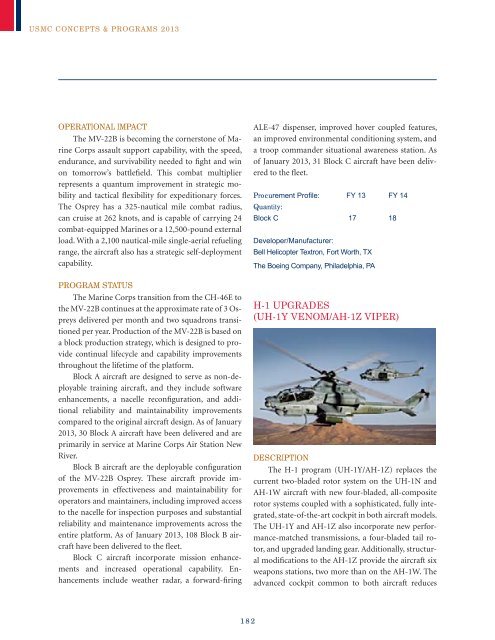USMC Concepts & Programs 2013 - Defense Innovation Marketplace
USMC Concepts & Programs 2013 - Defense Innovation Marketplace
USMC Concepts & Programs 2013 - Defense Innovation Marketplace
Create successful ePaper yourself
Turn your PDF publications into a flip-book with our unique Google optimized e-Paper software.
<strong>USMC</strong> <strong>Concepts</strong> & <strong>Programs</strong> <strong>2013</strong><br />
Operational Impact<br />
The MV-22B is becoming the cornerstone of Marine<br />
Corps assault support capability, with the speed,<br />
endurance, and survivability needed to fight and win<br />
on tomorrow’s battlefield. This combat multiplier<br />
represents a quantum improvement in strategic mobility<br />
and tactical flexibility for expeditionary forces.<br />
The Osprey has a 325-nautical mile combat radius,<br />
can cruise at 262 knots, and is capable of carrying 24<br />
combat-equipped Marines or a 12,500-pound external<br />
load. With a 2,100 nautical-mile single-aerial refueling<br />
range, the aircraft also has a strategic self-deployment<br />
capability.<br />
Program Status<br />
The Marine Corps transition from the CH-46E to<br />
the MV-22B continues at the approximate rate of 3 Ospreys<br />
delivered per month and two squadrons transitioned<br />
per year. Production of the MV-22B is based on<br />
a block production strategy, which is designed to provide<br />
continual lifecycle and capability improvements<br />
throughout the lifetime of the platform.<br />
Block A aircraft are designed to serve as non-deployable<br />
training aircraft, and they include software<br />
enhancements, a nacelle reconfiguration, and additional<br />
reliability and maintainability improvements<br />
compared to the original aircraft design. As of January<br />
<strong>2013</strong>, 30 Block A aircraft have been delivered and are<br />
primarily in service at Marine Corps Air Station New<br />
River.<br />
Block B aircraft are the deployable configuration<br />
of the MV-22B Osprey. These aircraft provide improvements<br />
in effectiveness and maintainability for<br />
operators and maintainers, including improved access<br />
to the nacelle for inspection purposes and substantial<br />
reliability and maintenance improvements across the<br />
entire platform. As of January <strong>2013</strong>, 108 Block B aircraft<br />
have been delivered to the fleet.<br />
Block C aircraft incorporate mission enhancements<br />
and increased operational capability. Enhancements<br />
include weather radar, a forward-firing<br />
ALE-47 dispenser, improved hover coupled features,<br />
an improved environmental conditioning system, and<br />
a troop commander situational awareness station. As<br />
of January <strong>2013</strong>, 31 Block C aircraft have been delivered<br />
to the fleet.<br />
Procurement Profile: FY 13 FY 14<br />
Quantity:<br />
Block C 17 18<br />
Developer/Manufacturer:<br />
Bell Helicopter Textron, Fort Worth, TX<br />
The Boeing Company, Philadelphia, PA<br />
H-1 Upgrades<br />
(UH-1Y Venom/AH-1Z Viper)<br />
Description<br />
The H-1 program (UH-1Y/AH-1Z) replaces the<br />
current two-bladed rotor system on the UH-1N and<br />
AH-1W aircraft with new four-bladed, all-composite<br />
rotor systems coupled with a sophisticated, fully integrated,<br />
state-of-the-art cockpit in both aircraft models.<br />
The UH-1Y and AH-1Z also incorporate new performance-matched<br />
transmissions, a four-bladed tail rotor,<br />
and upgraded landing gear. Additionally, structural<br />
modifications to the AH-1Z provide the aircraft six<br />
weapons stations, two more than on the AH-1W. The<br />
advanced cockpit common to both aircraft reduces<br />
182

















